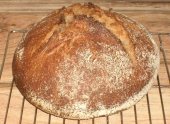posted 14 years ago
Hi, all -
Wanted to share a couple of the techniques I've learned for making really nice, artisan loaves.
High hydration bread dough is key to getting the kind of crumb that one finds in an artisan loaf. The crumb ideally is open, with some good sized bubbles, and looking into those bubbles the interiors of the bubbles are glossy. A slice of the bread, held up to the light, is translucent, and the texture of the crumb is chewy, not starchy.
There are difficulties inherent to working with a high-hydration dough, the most significant being that they are loose and sticky enough to require special techniques when hand-kneading.
I use a combination of a couple of techniques. First, I knead in the bowl, shaping my hand into a scoop like a dough hook, grabbing a good portion of the dough and lifting/stretching it upward until it snaps in half or separates from the bottom of the bowl. Then drop it down and repeat.
Second, I use Peter Reinhart's trick of three brief kneadings separated by 15 -30 minutes rest. I get up in the morning, incorporate the additional flour into the dough, and knead for maybe five minutes. Make some coffee, answer e-mails, and then knead again. More coffee, or a bowl of oatmeal, knead a third time, put the dough in an oiled bowl and stick it in the fridge.
The gluten develops this way much easier than with continuous kneading.
The other trick in making an artisan-quality loaf is delayed fermentation. By sticking the dough in the fridge for a day after the bread is kneaded, the direct action of the yeast, basically eating sugar, peeing alcohol and belching CO2, is retarded, but the action of the enzymes secreted by the yeast, which break down the starch into sugar, are not. So the end product is lower in starch, with more sugars to feed the yeast. The higher natural sugar content also has an effect on the crust, which tends to caramelize more and develop more complex flavors.
The combination of high hydration and delayed fermentation is a big part of what distinguishes the poilane loaf that Hollywood hoipaloi pay $50 a loaf for, flown in from Paris.
How do y'all do it?










